Papers by Carlos J. Escudero
IEEE Internet of Things Journal
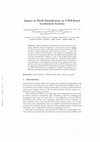
International Conference on Indoor Positioning and Indoor Navigation, 2019
When considering localization systems, one of the most commonly employed reference parameters is ... more When considering localization systems, one of the most commonly employed reference parameters is the so-called two-way ranging. To obtain this parameter, technologies such as ultra-wideband (UWB) exploit the signal propagation time between two devices: a target and an anchor. However, this parameter is not immune to propagation phenomena such as shadowing, reflections, and diffractions frequently found in indoor environments, leading to a loss of line-of-sight (LOS) conditions between the target and the anchor (i.e., non-line-of-sight (NLOS) conditions), hence degrading the ranging estimations and, consequently, the performance of the algorithms used for the localization. This work studies how the prior knowledge about LOS and NLOS conditions allows for improving considerably the final position estimations. Results based on UWB measurements are considered to evaluate the performance of different positioning algorithms with and without this prior information.
This repository contains ROS bags with measurements related to the article "Forklift Positio... more This repository contains ROS bags with measurements related to the article "Forklift Positioning System for Pallet Tracking in Industrial Environments". The dataset includes measurements from UWB tags, IMU, Magnetometer and Px4Flow simulated in Gazebo. Also includes the position estimations calculated using the algorithm described in the related paper.
This dataset includes the measurements of a simulated vehicle inside a Gazebo simulation using di... more This dataset includes the measurements of a simulated vehicle inside a Gazebo simulation using different sensors: a simulated UWB tag, a IMU and a PX4Flow.
Indoor positioning systems based on radio frequency systems such as UWB inherently present multip... more Indoor positioning systems based on radio frequency systems such as UWB inherently present multipath related phenomena. This causes ranging systems such as UWB}to lose accuracy by detecting secondary propagation paths between two devices. If a positioning algorithm uses ranging measurements without considering these phenomena, it will make important errors in estimating the position. This work analyzes the performance obtained in a localization system when combining location algorithms with machine learning techniques for a previous classification and mitigation of the propagation effects. For this purpose, real cross scenarios are considered, where the data extracted from UWB low-cost devices for the training of the algorithms come from different environments than those considered for the real application and its analysis.
The estimation of the propagation model parameters is a main issue in location systems. In these ... more The estimation of the propagation model parameters is a main issue in location systems. In these systems, distance estimations are obtained from received signal strength information, which is extracted from received packets. The precision of these systems mainly depends on the proper propagation model selection. In this paper we introduce an algorithm based on Bayesian filtering techniques, which estimate the path-loss exponent of a lognormal propagation model. This estimation is made dynamically and in real time. Therefore, it can track propagation model changes due to environmental changes.
This paper deals with the problem of blind interference suppression in Direct-Sequence Code Divis... more This paper deals with the problem of blind interference suppression in Direct-Sequence Code Division Multiple Access (DS/CDMA) channels. We investigate the incorporation of linear constraints to the Constant Modulus (CM) criterion to obtain a new blind adaptive receiver that only requires chip synchronization and acquisition of the desired user code. An analysis is presented that shows how linear constraints avoid the capture problem of the conventional CM criterion. Finally, an adaptive algorithm based on the Generalized Sidelobe Canceller 7] structure is proposed to solve the constrained optimization problem.
Eurasip Journal on Wireless Communications and Networking, 2012
ABSTRACT In this paper we propose a software architecture specifically designed for enabling soft... more ABSTRACT In this paper we propose a software architecture specifically designed for enabling software-defined radio using several hardware nodes (transmitters and/or receivers) at the same time and designed under the premises of being scalable as well as distributed. Additionally, the software architecture supports remote interaction with the hardware nodes, thus enabling remote configuration and control of all hardware nodes from a centralized point. As an example, we present an implementation of the software architecture for the case of Universal Software Radio Peripheral (USRP) nodes from Ettus Research LLC.
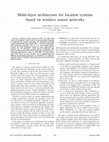
Abstract-Location systems based on WSN are built using diverse technologies. Factors such as the ... more Abstract-Location systems based on WSN are built using diverse technologies. Factors such as the programming language to implement the location algorithm, the underlying operating system (available libraries, closed APIs,...) and type of hardware node interfaces, frequently drive us to a non-reusable design. Usually, the WSN technology cannot be easily replaceable by another one. We introduce a novel layered architecture that allows the abstraction of both WSN and location algorithm layers, communicating them by means of XML-RPC. As main advantages, both layers are now reusable, can be implemented with different programming languages, be distributed over different machines and it is possible a concurrent access to the WSN from different clients. I. INTRODUCCIÓN The design of a location system based on WSN [1] often arise doubts about the technology and the software that will be used. The technology used for the sensor network (WiFi, Bluetooth, ZigBee, etc.) is often set in the first...

IEEE Access, 2020
ultra-wideband (UWB) technology enables centimeter-level localization systems based on the accura... more ultra-wideband (UWB) technology enables centimeter-level localization systems based on the accurate estimation of the actual distance between transmitter and receiver, by means of the precise estimation of the signal time-of-flight. However, this is only possible when correctly detecting the first path of the incoming signal instead of a bounce or a reflection, which becomes challenging in non line-of-sight (NLOS) situations. There are many different approaches in the literature to alleviate the wrong detection of the first incoming UWB signal path. One of them considers machine learning techniques to design classifiers capable of distinguishing between line-of-sight (LOS) and NLOS propagation from available signal features. However, the performance and complexity of the obtained classifiers depend largely on the size of the input data associated to such features. Thus, features such as the channel impulse response (CIR) produce large amounts of data, yielding very complex classifie...
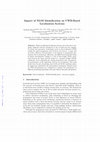
When considering localization systems, one of the most commonly employed reference parameters is ... more When considering localization systems, one of the most commonly employed reference parameters is the so-called two-way ranging. To obtain this parameter, technologies such as ultra-wideband (UWB) exploit the signal propagation time between two devices: a target and an anchor. However, this parameter is not immune to propagation phenomena such as shadowing, reflections, and diffractions frequently found in indoor environments, leading to a loss of line-of-sight (LOS) conditions between the target and the anchor (i.e., non-line-of-sight (NLOS) conditions), hence degrading the ranging estimations and, consequently, the performance of the algorithms used for the localization. This work studies how the prior knowledge about LOS and NLOS conditions allows for improving considerably the final position estimations. Results based on UWB measurements are considered to evaluate the performance of different positioning algorithms with and without this prior information.

Ultra-wideband (UWB) devices have been largely considered for indoor location systems due to thei... more Ultra-wideband (UWB) devices have been largely considered for indoor location systems due to their high accuracy. However, as in other wireless systems, such accuracy is significantly degraded under non-line-of-sight (NLOS) propagation conditions. Therefore, the identification of NLOS conditions is essential to mitigate inaccuracies due to NLOS propagation. Nonetheless, most of the techniques considered to identify NLOS situations are based on the study of the channel impulse response (CIR), which is not practical and even becomes unfeasible when employing low-cost UWB hardware. This is precisely the main motivation of this work, to introduce a classification system based on the statistics of both the received signal strength (RSS) and range available from low-cost UWB devices.We analyze the effect of considering different statistic sets of both the RSS and range as features to feed a support vector machine (SVM) classifier, which is experimentally evaluated by means of measurements...
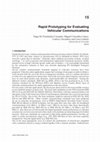
During the last years, wireless communications between moving vehicles (Vehicle-To-Vehicle, VTV o... more During the last years, wireless communications between moving vehicles (Vehicle-To-Vehicle, VTV or V2V) and from vehicles to infrastructure (V2I or Roadside-to-Vehicle, RTV) have received a great deal of attention. Vehicular safety (collision prevention systems, accident warnings...) as well as payment and infotainment applications (automatic payment, mobile internet access at high vehicular speeds, traffic jam avoidance...) are increasingly demanded by the automotive industry in their way towards deploying ITS (Intelligent Transport Systems). Several wireless communication standards targeted to vehicular scenarios have been proposed. Vehicular safety applications require fast exchange of messages in order to obtain a swift reaction from the car or the driver in dangerous situations, such as a sudden slowdown or when two cars approach an intersection. Due to the necessary quick response, transceivers have to send short packets and, therefore, small bandwidths are demanded. Among the...
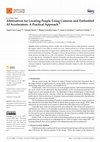
Engineering Proceedings
Indoor positioning systems usually rely on RF-based devices that should be carried by the targets... more Indoor positioning systems usually rely on RF-based devices that should be carried by the targets, which is non-viable in certain use cases. Recent advances in AI have increased the reliability of person detection in images, thus, enabling the use of surveillance cameras to perform person localization and tracking. This paper evaluates the performance of indoor person location using cameras and edge devices with AI accelerators. We describe the video processing performed in each edge device, including the selected AI models and the post-processing of their outputs to obtain the positions of the detected persons and allow their tracking. The person location is based on pose estimation models as they provide better results than do object detection networks in occlusion situations. Experimental results are obtained with public datasets to show the feasibility of the solution.
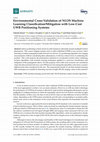
Sensors
Indoor positioning systems based on radio frequency inherently present multipath-related phenomen... more Indoor positioning systems based on radio frequency inherently present multipath-related phenomena. This causes ranging systems such as ultra-wideband (UWB) to lose accuracy when detecting secondary propagation paths between two devices. If a positioning algorithm uses ranging measurements without considering these phenomena, it will face critical errors in estimating the position. This work analyzes the performance obtained in a localization system when combining location algorithms with machine learning techniques applied to a previous classification and mitigation of the propagation effects. For this purpose, real-world cross-scenarios are considered, where the data extracted from low-cost UWB devices for training the algorithms come from a scenario different from that considered for the test. The experimental results reveal that machine learning (ML) techniques are suitable for detecting non-line-of-sight (NLOS) ranging values in this situation.
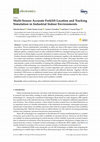
Electronics
Location and tracking needs are becoming more prominent in industrial environments nowadays. Proc... more Location and tracking needs are becoming more prominent in industrial environments nowadays. Process optimization, traceability or safety are some of the topics where a positioning system can operate to improve and increase the productivity of a factory or warehouse. Among the different options, solutions based on ultra-wideband (UWB) have emerged during recent years as a good choice to obtain highly accurate estimations in indoor scenarios. However, the typical harsh wireless channel conditions found inside industrial environments, together with interferences caused by workers and machinery, constitute a challenge for this kind of system. This paper describes a real industrial problem (location and tracking of forklift trucks) that requires precise internal positioning and presents a study on the feasibility of meeting this challenge using UWB technology. To this end, a simulator of this technology was created based on UWB measurements from a set of real sensors. This simulator was...
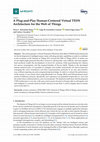
Sensors (Basel, Switzerland), Jan 27, 2018
This article presents a Virtual Transducer Electronic Data Sheet (VTEDS)-based framework for the ... more This article presents a Virtual Transducer Electronic Data Sheet (VTEDS)-based framework for the development of intelligent sensor nodes with plug-and-play capabilities in order to contribute to the evolution of the Internet of Things (IoT) toward the Web of Things (WoT). It makes use of new lightweight protocols that allow sensors to self-describe, auto-calibrate, and auto-register. Such protocols enable the development of novel IoT solutions while guaranteeing low latency, low power consumption, and the required Quality of Service (QoS). Thanks to the developed human-centered tools, it is possible to configure and modify dynamically IoT device firmware, managing the active transducers and their communication protocols in an easy and intuitive way, without requiring any prior programming knowledge. In order to evaluate the performance of the system, it was tested when using Bluetooth Low Energy (BLE) and Ethernet-based smart sensors in different scenarios. Specifically, user experi...
Proceedings of the Sixth Iasted International Conference on Communication Systems and Networks, Aug 9, 2007
ABSTRACT This paper presents an analysis of the inquire Bluetooth procedure. This analysis obtain... more ABSTRACT This paper presents an analysis of the inquire Bluetooth procedure. This analysis obtains optimum parameters to improve the performance of this mechanism in order to reduce the time necessary to discover Bluetooth devices in a coverage area. It is shown how the default parameters, specified in the standard, are not optima at all and new adjustements have been achieved in order to reduce the discovering time of new bluetooth devices. By other hand, we show the results obtained for different number of master and slave devices and their influence in the time and probability of discovering devices.










Uploads
Papers by Carlos J. Escudero